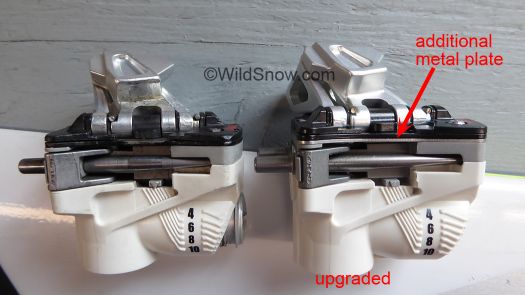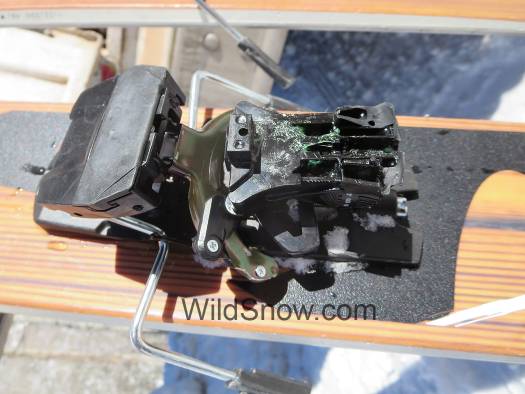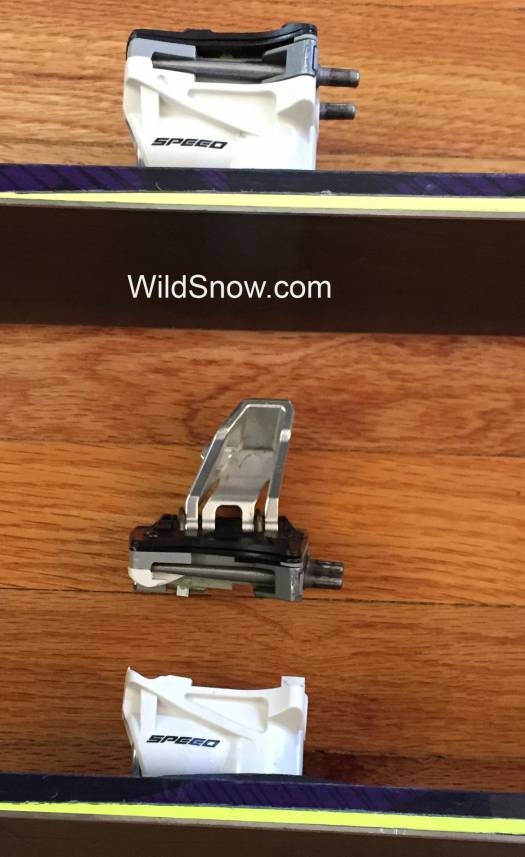UPDATE: January 2016. It appears there have been (at least) THREE different versions of this binding heel unit upgrade.
1. First version added the reinforcement rib to the lower plastic housing, but did not add stronger screws (see photos below).
2. Second version has stronger screws as well as the rib.
3. Third version adds a metal plate below the top plate, along with the two upgrades above.
THE INFORMATION BELOW COULD BE CONFUSING DUE TO THESE DIFFERENT ITERATIONS. IN MY OPINION MOST SKIERS WILL PROBABLY BE OK WITH VERSION 2 (stronger screws and reinforced housing) but larger and/or aggressive skiers in my opinion should be on version 3. THE PHOTO OF SPEED RADICAL ver 3 BELOW SHOWS THE ADDED METAL PLATE.
UPDATE: Sept 9, see bottom of post for official info Dynafit sent to North American dealers.
UPDATE: Sept 2, added information about binding heel unit top plate-cap screws.
We’ve heard of and seen in person the top plate broken off Dynafit Radical 1.0 versions (FT, ST, Speed) ski touring bindings. This is not uncommon. Check out the photos below.
Word from Dynafit is yes, first generation Radical FT/ST/Speed may be weak, manufactured 2011-2012. More recent versions have a reinforced rear housing, with stronger top plate and screws.
If you have the weaker versions, Dynafit North America has a swap program for the heel unit — Dynafit Service in North America, same in Europe. You’ll probably be able to do this directly if you like, or work through a dealer.
(Note, there are no issues with any Radical toe units — AND REMEMBER THIS IS ONLY FOR THE EARLIER RADICAL HEELS; try and swap a later heel and you’ll just be making trouble for yourself and others, so photos above and below for ID.)
Dynafit claims the later version has no unusual problem with heel unit top-plate strength. They say the breakage we’ve been discussing here at WildSnow.com are in the earlier binding versions. Thankfully, differentiation is easy. The, in my opinion best, later version has an extra metal plate under the top plate. See photo above.
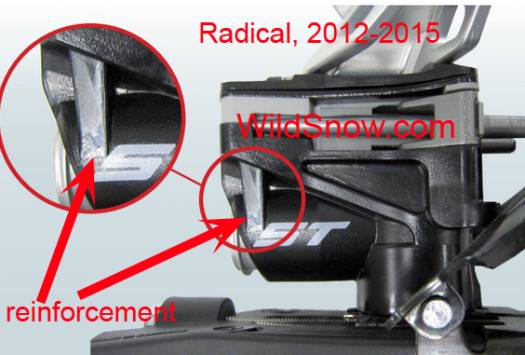
Radical binding 2012-2015 version is identified by this reinforcement rib on rear plastic housing. If you carefully compare to photo below, you’ll also notice the plastic is thicker at the base of the housing, that’s quite important in my opinion and is a major upgrade. Photo from Dynafit.
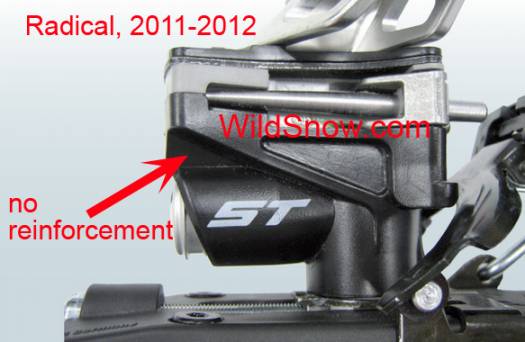
Original binding does NOT have the reinforcement, and also has weaker screws and top plate. Photo from Dynafit.
Frankly, I would have liked to see this announcement and return program happen some time ago. Yet to be fair, this kind of thing is not easy as it’s based on global consumer return numbers, and such metrics take time to gather. The other side to that is of course “make a stronger binding in the first place.” I’d agree, but making a ski touring binding strong, light, and functional is simply not easy. Thus, we might see the day of a flawless tech binding, but don’t hold your breath. Do support companies who stand behind their products. Apparently Dynafit is doing just that.
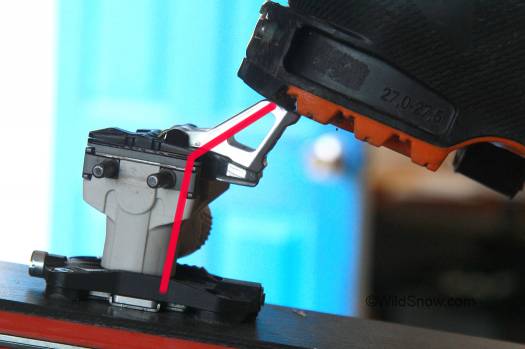
All Dynafit Radical 1.0 versions, Speed, FT, ST have the nice flipper heel lifters. What in my opinion caused the problem is that weight of a person on the lifter causes a bend in the 'line of force" and possibly damaging leverage and force on the binding top plate attachment. There is however some debate — it is possible the damage is simply caused by the binding housing and screws not being strong enough to handle forces produced by bindings set to high release values. In any case, the updated version will be easy to come by if you don’t have it — though you’ll have to do a heel unit re-mount.
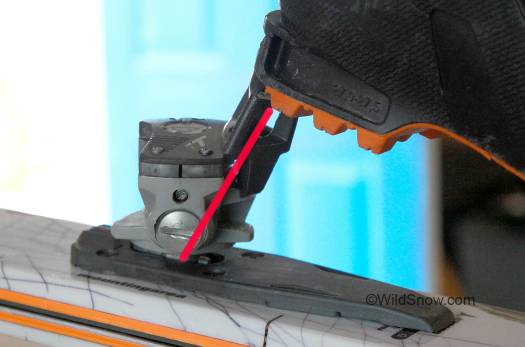
Dynafit Vertical series bindings had a heel lifter with a pretty much straighter line of force that did not unduly work the top plate.
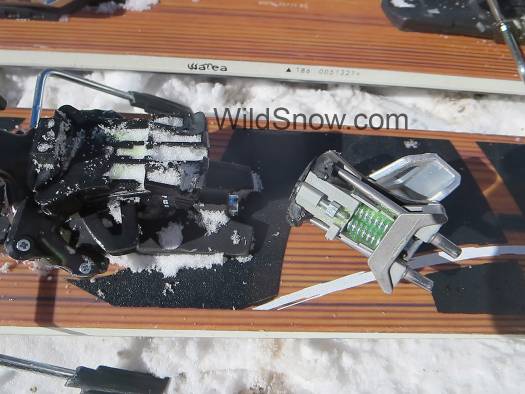
Known issue with Radical 1.0, one or two top plate screws probably get fatigued from all the movement and force from the heel lifters, then a screw breaks and the top plate gets ripped off. This is unfun and possibly even dangerous for backcountry skiing situations.
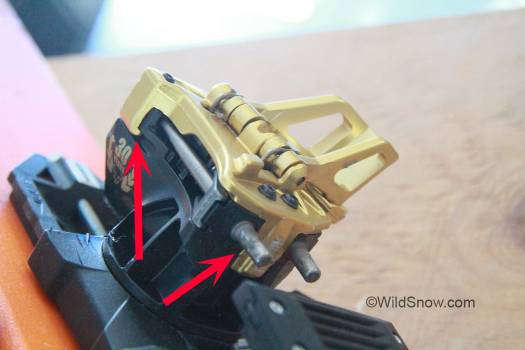
Radical 2.0 is much stronger. Note how the rear of the top plate has ‘claws’ that key into the housing, and the front has a lip of aluminum that mates with the housing and prevents wobble movement of the top plate. We anticipate ZERO strength problems with the 2.0 top plate assembly.
After you do the swap, or if you already have bindings with the reinforcement rib:
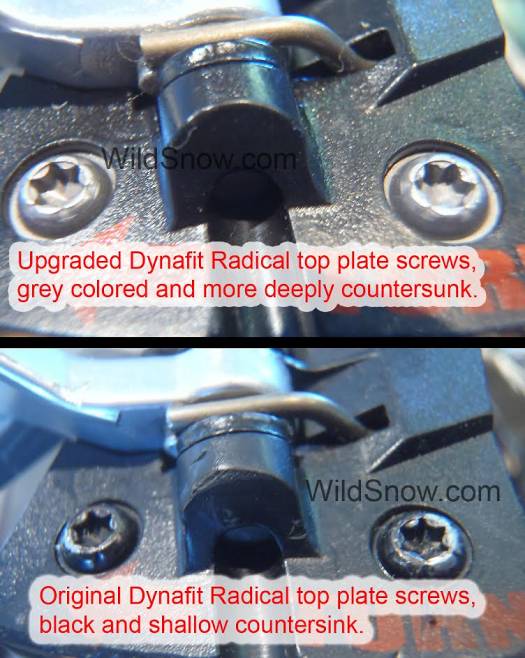
Apparently there are two versions of the reinforced binding out there, one with original black screws, and one with an “in line” change to grey screws that in our opinion after research are stronger. A reader kindly sent these photos over, I’ll do a more detailed screw comparo when I have more of this season’s retail bindings on hand. Insider at Dynafit tells us that they will NOT swap bindings based on type of screws, as they don’t feel there is any meaningful breakage problem caused by the screws. In other words, they feel that the reinforced binding housing is the key. Thus we have to guess and assume they upgraded the screws just for insurance that they were beefing all the right stuff. We are not sure where to go with this in terms of opinion writing-blogging. On the one hand, we like the idea of stronger screws. On the other hand we have not personally experienced any breakage we can blame solely on the screws — though we have had emails that showed photos indicating the broken black screws were the root of top plate failures. Rather confusing. From an engineering standpoint, we do “stand” by our opinion that the angle of the flipping heel lifter puts quite a bit of strain on the screws and they could be prone to fatigue and breakage the triggers a cascading failure that involves the rear housing, but that’s just theory. At this point let’s just say that if you do swap your binding heels, you want to receive replacements with the grey screws so you get the “full monty” in terms of beef. Otherwise, unless you are a very heavy user of Radicals (more than average weight, hundreds of hours on high heel lift), just be sure you have the reinforced heels — with either black or grey screws.
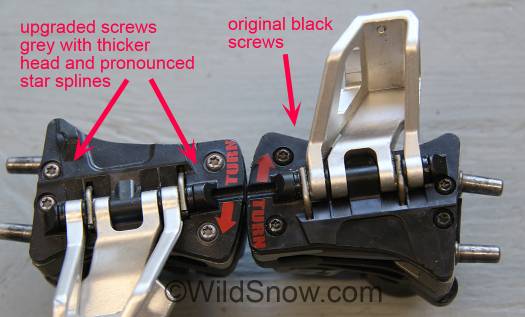
For those of you who want to make sure you get the grey stronger screws, I made another photo that’ll help you with comparo. Both the housings in this photo are ‘gen 2’ with the reinforcement rib.
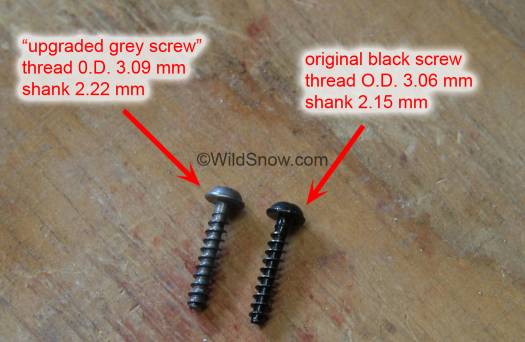
To be clear, check out the screws in all their naked glory. Grey upgraded screw is visibly larger. When a fastener is this small, slight changes in size and material strength can equal huge percentage changes in durability.
In case anyone is wondering, the Speed Radical is also subject to issues. Even if it has the reinforcement rib on the lower rear housing, you should still be rocking the stronger screws in my opinion. WildSnow reader Erich testifies and sent in the following photos.
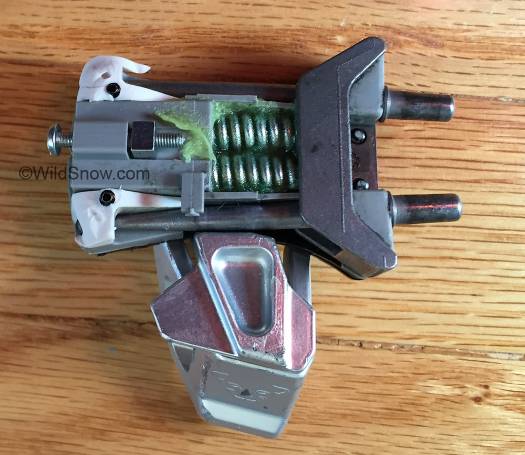
Another view of Erich’s blown up heel unit. Notice how the front screws are cleanly broken while the rear involved the plastic breaking as well as the screws.
(Editor note, dealers received this around September 8, 2015)
Attn: DYNAFIT Dealers:DYNAFIT International has recently announced a service program related to the Radical 1 (v1) binding. Research found the first generation of Radical 1 and Speed Radical bindings sold in the 2011/2012 season had an outlying number of broken heels. ALL later generations have been reinforced with regards to housing, top metal plate and screws. (Editors note, see above on how to verify your bindings have the stronger screws, housing, etc.)
DYNAFIT NA is committed to offering the best possible service and we have decided to issue a free service update for consumers with first generation Radical bindings. DYNAFIT NA will exchange any pair of v1 heels with the updated v2 at no charge.
1. Please inform your service team about the free update.
2. Please offer the free update if you see first generation bindings coming in for service, etc. Please see the attached document to note the v1 vs. v2 visual differences.
4. Consumers can also contact us directly at the Boulder offices to request this free update.
5. Replacement ST heels will be available November 1, 2015. Replacement FT heels will be available December 15th, 2015.
WildSnow.com publisher emeritus and founder Lou (Louis Dawson) has a 50+ years career in climbing, backcountry skiing and ski mountaineering. He was the first person in history to ski down all 54 Colorado 14,000-foot peaks, has authored numerous books about about backcountry skiing, and has skied from the summit of Denali in Alaska, North America’s highest mountain.

